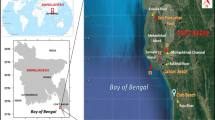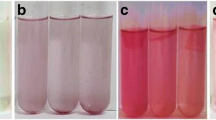Abstract
Studying plastic characteristics in the marine environment is important to better understand interaction between plastics and the environment. In the present study, high-density polyethylene (HDPE), polyethylene terephalate (PET), and polyvinyl chloride (PVC) samples were collected from the coastal environment in order to study their surface properties. Surface properties such as surface functional groups, surface topography, point of zero charge, and color change are important factors that change during degradation. Eroded HDPE demonstrated an altered surface topography and color and new functional groups. Eroded PET surface was uneven, yellow, and occasionally, colonized by microbes. A decrease in Fourier transform infrared (FTIR) peaks was observed for eroded PET suggesting that degradation had occurred. For eroded PVC, its surface became more lamellar and a new FTIR peak was observed. These surface properties were obtained due to degradation and could be used to explain the interaction between plastics, microbes, and pollutants.











Similar content being viewed by others
References
Albertsson AC, Andersson SO, Karlsson S (1987) The mechanism of biodegradation of polyethylene. Polym Degrad Stabil 18:73–87
Ammala A, Bateman S, Dean K, Petinakisa E, Sangwan P, Wong S, Yuan Q, Yu L, Patrick C, Leong KH (2011) An overview of degradable and biodegradable polyolefins. Prog Polym Sci 36:1015–1049
Andrady AL, Neal MA (2009) Applications and societal benefits of plastic. Philos T R Soc Lon B 364:1977–1984
Artham T, Sudhakar M, Venkatesan R, Madhavan NC, Murty KVGK, Doble M (2009) Biofouling and stability of synthetic polymers in sea water. Int Biodeter Biodegrad 63:884–890
Barnes DKA (2002) Biodiversity: invasions by marine life on plastic debris. Nature 416:808–809
Barnes DKA, Galgani F, Thompson RC, Barlaz M (2009) Accumulation and fragmentation of plastic debris in global environments. Philos T R Soc Lon B 364:1985–1998
Cheng S, Dehaye F, Bailly C, Biebuyck JJ, Legras R, Parks L (2005) Studies on polyethylene pellets modified by low dose radiation prior to part formation. Nucl Instrum Methods 236:130–136
Chiellini E, Corti A, D’Antone S, Baciu R (2006) Oxo-biodegradable carbon backbone polymers e Oxidative degradation of polyethylene under accelerated test conditions. Polym Degrad Stabil 91:2739–2747
Deka KB, Maji TK (2010) Effect of coupling agent and nanoclay on properties of HDPE, LDPE, PP, PVC blend and Phargamites karka nanocomposite. Compos Sci Technol 70:1755–1761
Dussud C, Ghiglione JF (2014) Bacterial degradation of synthetic plastics. In CIESM Workshop Monograph no46 [F.Briand, ed.] Plastic litter and dispersion of alien species and contaminant in the Mediterranean Sea. CIESM Publisher, Monaco.
Edge M, Hayes M, Mohammadian M, Allen NS, Jewitt TS (1991) Aspects of poly(ethylene terephthalate) degradation for archival life and environmental degradation. Polym Degrad Stabil 32:131–153
Edge M, Wiles R, Allen NS, McDonald WA, Mortlock SV (1995) Characterisation of the species responsible for yellowing in melt degraded aromatic polyesters-I: yellowing of poly(ethylene- terephthalate). Polym Degrad Stabil 53:141–151
Endo S, Takizawa R, Okuda K, Takada H, Chiba K, Kanehiro H, Ogi H, Yamashita R, Date T (2005) Concentration of polychlorinated biphenyls (PCBs) in beached resin pellets: variability among individual particles and regional differences. Mar Pollut Bull 50:1103–1114
Fecline GJM, Rabello MS, Souto-Maior RM (2001) The effect of ultraviolet stabilizers on the photodegradation of poly(ethylene terephthalate). Polym Degrad Stabil 75:153–159
Fotopoulou NK, Karapanagioti KH (2012) Surface properties of beached plastic pellets. Mar Environ Res 81:70–77
Graca B, Beldowska M, Wrzesie P, Zgrundo A (2014) Styrofoam debris as a potential carrier of mercury within ecosystems. Environ Sci Pollut Res 21:2263–2271
Gulmine JV, Janissek PR, Heise HM, Akcelrud L (2003) Degradation profile of polyethylene after artificial accelerated weathering. Polym Degrad Stabil 79:385–397
Hadad D, Geresh S, Sivan A (2005) Biodegradation of polyethylene by the thermophilic bacterium Brevibacillus borstelensis. J Appl Microbiol 98:1093–1100
Harshvardhan K, Jha B (2013) Biodegradation of low-density polyethylene by marine bacteria from pelagic waters, Arabian Sea, India. Mar Pollut Bull 77:100–106
Holmes LA, Turner A, Thompson CR (2014) Interactions between trace metals and plastic production pellets under estuarine conditions. Mar Chem 167:25–32
Ioakeimidis C, Zeri C, Kaberi H, Galatchi M, Antoniadis K, Streftaris N, Galgani F, Papathanassiou E, Papatheodorou G (2014) Comparative study of marine litter on the seafloor of coastal areas in the Eastern Mediterranean and Black Seas. Mar Pollut Bull 89:1–2
Ito M, Nagai K (2007) Analysis of degradation mechanism of plasticized PVC under artificial aging conditions. Polym Degrad Stabil 92:260–270
Jakubowicz I, Yarahmadi N, Petersen H (2006) Evaluation of the rate of abiotic degradation of biodegradable polyethylene in various environments. Polym Degrad Stabil 91:1556–1562
Kochkodan V, Johnson JD, Hilal N (2014) Polymeric membranes: surface modification for minimizing (bio)colloidal fouling. Adv Colloid Interfac 206:116–140
Koutny M, Sancelme M, Dabin C, Pichon N, Delort AM, Lemaire J (2005) Acquired biodegradability of polyethylenes containing pro-oxidant additives. Polym Degrad Stabil 91:1495–1503
Kyrikou I, Briassoulis D, Hiskakis M, Babou E (2011) Analysis of photo-chemical degradation behaviour of polyethylene mulching film with pro-oxidants. Polym Degrad Stabil 96:2237–2252
Muthukumar T, Aravinthan A, Lakshmi K, Venkatesan R, Vedaprakash L, Doble M (2011) Fouling and stability of polymers and composites in marine environment. Int Biodeter Biodegrad 65:276–284
Orr GI, Hadar Y, Sivan A (2004) Colonization, biofilm formation and biodegradation of polyethylene by a strain of Rhodococcus ruber. Appl Microbiol Biotechnol 65:97–104
Parthasarathi V, Sundaresan B, Dhanalakshmi V, Anbarasan R (2010) Functionalization of HDPE with aminoester and hydroxyester by thermolysis method—an FTIR-RI approach. Thermochi Acta 510:61–67
Pastorelli G, Cucci C, Garcia O, Piantanida G, Elnaggar A, Cassar M, Strlic M (2014) Environmentally induced colour change during natural degradation of selected polymers. Polym Degrad Stabil 107:198–209
PlasticsEurope, Association of Plastics Manufacturers, (2012) Plastics the Facts 2012. Available from http://www.plasticseurope.org/Document/plastics-the-facts-2012.aspx
PlasticsEurope, Association of Plastics Manufacturers, (2013) Plastics the Facts 2013. Available from http://www.plasticseurope.org/Document/plastics-the-facts-2013.aspx
Ranby B (1989) Photodegradation and photo-oxidation of synthetic polymers. J Anal Pyrol 15:237–247
Restrepo-Flórez JM, Bassi A, Thompson MR (2014) Microbial degradation and deterioration of polyethylene—a review. Int Biodeter Biodegrad 88:83–90
Rochman CM, Browne MA, Halpern BS, Hentschel BT, Hoh E, Karapanagioti HK, Rios- Mendoza LM, Takada H, Teh S, Thompson RC (2013) Policy: classified plastic waste as hazardous. Nature 494:169–171
Saisinchai S (2013) Separation of PVC from PET/PVC mixtures using flotation by calcium lignosulfonate depressant. Eng J 18:45–54
Sakata Y, Uddin MA, Koizumi K, Murata K (1996) Thermal degradation of polyethylene mixed with poly(vinyl chloride) and poly(ethyleneterephthalate). Polym Degrad Stabil 53:111–117
Sammon C, Yarwood J, Everall N (2000) An FT ± IR study of the effect of hydrolytic degradation on the structure of thin PET films. Polym Degrad Stabil 67:149–158
Shah AA, Hasan F, Hameed A, Ahmed S (2008) Biological degradation of plastics: a comprehensive review. Biotechnol Adv 26:246–265
Singh B, Sharma N (2008) Mechanistic implications of plastic degradation. Polym Degrad Stabil 93:561–584
Sivan A, Szanto M, Pavlov V (2006) Biofilm development of the polyethylenedegrading bacterium Rhodococcus ruber. Appl Microbiol Biot 72:346–352
Smith R (2005) Biodegradable polymers for industrial applications. Woodhead Publishing limited, Cambridge England, p 357
Sudhakar M, Trishul A, Doble M, Kumar KS, Jahan SS, Inbakandan D, Viduthalai RR, Umadevi VR, Murthy PS, Venkatesan R (2007) Biofouling and biodegradation of polyolefins in ocean waters. Polym Degrad Stabil 92:1743–1752
Tribedi P, Sil KA (2013) Low-density polyethylene degradation by Pseudomonas sp. AKS2 biofilm. Environ Sci Pollut R 20:4146–4153
Tung FD, Wiles M, Cermak BE, Gho JG, Hare CWJ (1999) Add con'99 Conference, Prague, Czechoslovakia, pp 207. [October 27–28]
Vakros J, Kordulis C, Lycourghiotis A (2002) Potentiometric mass titration: a quick scan for determining the point of zero charge. Chem Commun 17:1980–1981
Webb HK, Crawford RJ, Sawabe T, Ivanova EP (2009) Poly(ethylene terephthalate) polymer surfaces as a substrate for bacterial attachment and biofilm formation. Microbes Environ 24:39–42
Yang R, Li Y, Yu J (2005) Photoestabilization of linear low density polyethylene by inorganic nanoparticles. Polym Degrad Stabil 88:168–174
Yang C, Ye L, Tian L, Peng T, Deng K, Zan L (2011) Photodegradation activity of polyvinyl chloride (PVC)-perchlorinated iron (II) phthalocyanine (FePcCl16) composite film. J Colloid Interf Sci 353:537–541
Yang WL, Neoh KG, Kang E, Teo SM, Rittschof D (2014) Polymer brush coatings for combating marine biofouling. Prog Polym Sci 39:1017–1042
Acknowledgments
We express special thanks to Ch. Kordulis, J. Kallitsis, J. Vakros, G. Bokias, and E. Kotsopoulou from the University of Patras for the helpful discussions. Part of the experiments were carried out in the laboratories of the Research groups of Catalysis and interfacial chemistry for environmental applications and of Advanced Polymers Hybrid Nanomaterials Research at the Department of Chemistry of the University of Patras.
Author information
Authors and Affiliations
Corresponding author
Additional information
Responsible editor: Philippe Garrigues
Rights and permissions
About this article
Cite this article
Fotopoulou, K.N., Karapanagioti, H.K. Surface properties of beached plastics. Environ Sci Pollut Res 22, 11022–11032 (2015). https://doi.org/10.1007/s11356-015-4332-y
Received:
Accepted:
Published:
Issue Date:
DOI: https://doi.org/10.1007/s11356-015-4332-y




